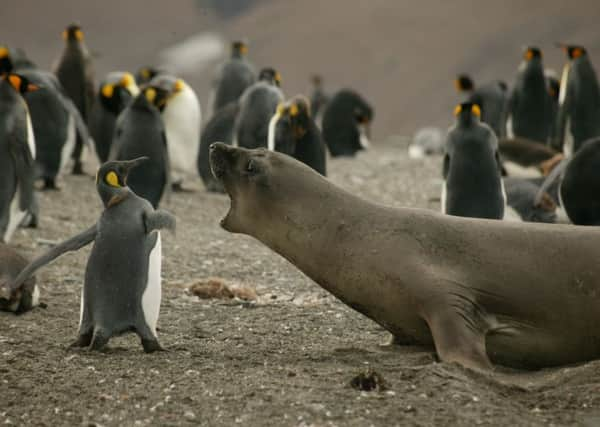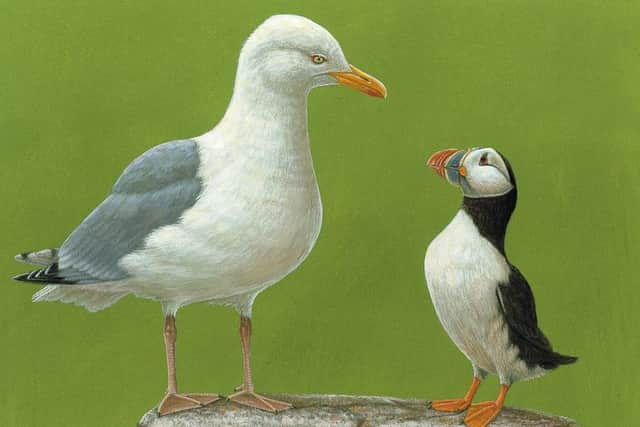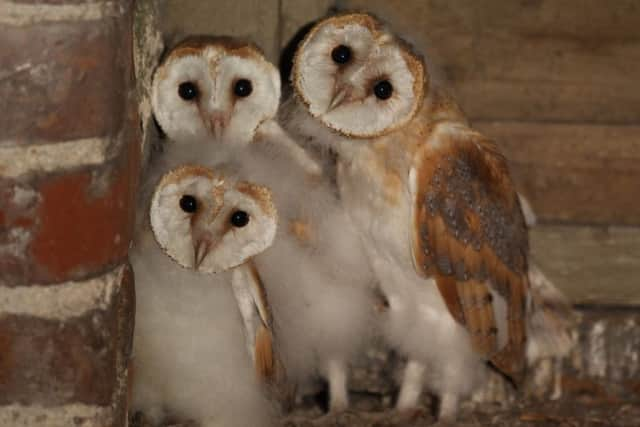Robert Fuller: Belly laughs make wildlife watching so much fun


When I’m watching an animal or bird up close I’m more or less guaranteed at least one heart-warming or laugh-out-loud moment.
This November I’m holding an art exhibition at my gallery in Thixendale to showcase the instants that have evoked the greatest belly laughs.
Advertisement
Hide AdAdvertisement
Hide AdAmong them was the time I travelled to Antarctica to watch penguins. Seeing them as they marched smartly in procession, with their wobbly, upright gait, and black and white tuxedo-looking feathers, was comical and the scene became even more amusing when I witnessed an instance of beach rage between a young king penguin and an elephant seal. The beach was crowded with elephant seals and this plucky penguin tried to barge its way through the crowd to the water’s edge.


The penguin walked into the path of a very large and grumpy elephant seal. The seal roared a warning but instead of retreating to safety like an older and wiser penguin might have done, the penguin retaliated; slapping the huge seal across the face with its flipper.
Puffins are the clowns of the UK wildlife scene. With bright orange legs, colourful bills and a waddling walk, it’s hard not to smile when you see one, especially if you spot it in flight with its wings whirring away as it propels its squat little body through the air.
Puffins spend eight months at sea before flying to shore in spring to breed. These noisy cliff top reunions have inspired many of my paintings. One features a puffin looking up at a herring gull.
Advertisement
Hide AdAdvertisement
Hide AdI’d been photographing a group of puffins socialising on a rock when the gull landed amongst them. All the puffins, bar this brave soul, scattered and wisely so since some gulls will swallow a puffin whole.


I watched anxiously as this one held its ground. The gull looked down its beak at the puffin, which was a fraction of its size. At that, the puffin rocked back on its heels before fleeing. I named my painting ‘Size Matters’.
At times I find myself adding a story line to such interactions, like the time I’d watched two hares courting. The male had tried to impress the female for three days but was yet to gain her favour. He’d put on an impressive show of boxing and was resting by her side, waiting for an opportunity to mate, when a male pheasant and his harem entered the scene. The male pheasant glanced condescendingly at the hare buck and then began to mate with a female. The pheasant then dismounted and walked up to the hare buck, looked him in the eye and puffed out his feathers. The buck was duly miffed and rose onto his back legs as if to box the cheeky pheasant.
The mating rituals of birds can be amusing. Black grouse perform a mating dance known as a ‘lek’ which involves the males fanning their tail feathers, strutting about making bubbling noises and leaping into the air calling. This is especially ludicrous when you notice the females standing on the edge of the lek looking nonchalant, as if unimpressed. However this is quite normal for black grouse and in fact the females are carefully selecting the best male mover.
Advertisement
Hide AdAdvertisement
Hide AdThere can scientific reasons behind behaviour we find funny. It’s hard not to smile when an owlet bobs its head up and down as it watches you. But this head-bobbing helps make up for an anatomical limitation: an owl’s eyes are fixed in position, so to look around it has to move its head. They also have flexible necks and can do 270 degrees of a full head turn, looking over one shoulder, around the back and almost over the opposite shoulder to help them judge space.


I watch birds of prey that live near my garden via cameras hidden in nests and have enjoyed priceless moments. Sometimes their behaviour is like ours, like the fussy female kestrel who niggled over each potential nest site her mate found - like newly-weds touring real estate. She even rejected a nest box the male had won for her in a bitter battle with a barn owl.
I watched with empathy as a barn owl mum struggled to work out how to brood her newly born owlets. She tried snuggling them under her but didn’t know where to put her talons. She kept lifting one foot, then the other, clenching her claws into tight fists, but still managed to stand on her young. Eventually she managed to sit on her new brood only to be disturbed by her mate’s arrival. She looked him in the eye and pecked at him in disbelief.
At times it is the animals that have turned me into a laughing stock such as the time I’d been trying to photograph a family of wild warthogs in Zimbabwe in the grounds of a hotel but they looked ridiculous as they were kneeling on a manicured lawn on their front legs with their backsides pointing up in the air.
Advertisement
Hide AdAdvertisement
Hide AdI walked up to the nearest one to try to get it to stand up straight but it charged at me, head-butted my foot and sent me hopping backwards across the lawn until we got to the edge of the lawn where it tossed its head and sent me and my camera flying into a flower bed that was being irrigated by an automatic watering system and got soaked. What I hadn’t realised was that I had an audience! I rose from the flowers to applause and laughter coming from the hotel bar and pool area.


Despite these dramas animals and birds make such good company; I wouldn’t have it any other way.
ANIMALS DO THE FUNNIEST THINGS
The Yorkshire Wolds-based wildlife artist as announced details of his latest exhibition of his latest work at his gallery in Thixendale.
The new exhibition, entitled ‘Animals do the Funniest Things’, will be held at the gallery between November 12 and December 4.
Advertisement
Hide AdAdvertisement
Hide AdAmong the artwork on display will be a collection of photographs and exclusive video footage from some of Mr Fuller’s most comic wildlife encounters.
Running alongside the displays are a programme of guided walks and falconry events, while a slideshow and talk on all of his amusing animal anecdotes will take place on November 19.
For more details see www.robertefuller.com